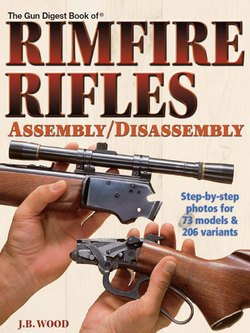Читать книгу The Gun Digest Book of Rimfire Rifles Assembly/Disassembly - J.B. Wood - Страница 20
На сайте Литреса книга снята с продажи.
ОглавлениеDisassembly:
1. Remove the magazine, open the bolt, and depress the bolt latch. Remove the bolt toward the rear.
2. Remove the stock mounting bolt, located just forward of the magazine well.
3. Remove the rear stock mounting bolt, located at the rear of the trigger guard unit.
4. Remove the trigger guard assembly downward. The magazine catch and its spring, located in the guard forward of the trigger, are best left in place in normal takedown. If removal is necessary for repair, insert a drift or rod through the loop at the rear of the catch, and draw it back until its side wings align with the exit cuts; then lift it out. Control the spring.
5. Remove the action from the stock, upward.
6. Drift out the roll pin at the front of the trigger housing.
7. Use an 8mm socket to remove the mounting bolt at the rear of the trigger housing. Take care that the lock washer is not lost.
8. Remove the trigger housing downward.
9. The bolt latch can be removed from the left side of the receiver by backing out its retaining and pivot screw. Restrain the latch as the screw is taken out, and ease it off. Remove the spring. In the front of the latch, a vertical roll pin retains the bolt stop/guide pin.
10. Because several of the parts in the trigger group are set or staked at the factory, disassembly of this system should be reserved for repair purposes. The sear pivot, for example, is riveted on both sides, and it is not routinely removable.
11. If necessary, the safety system can be removed. First, pry off the C-clip on the left side of the housing. Control it during removal, as it will snap off when freed.
12. Control the torsion spring, and remove the safety toward the right.
13. Remove the safety spring.
14. Move the connecting rod and the safety button out toward the rear.
15. The connecting rod is staked on the left side of the button, and these parts are not routinely separated.
16. Unhook the safety-lever spring at the rear to release its tension.
17. Insert a drift in the access hole on the right side, and drift out the safety-lever post toward the left. Remove the lever and spring.
18. In order to remove the safety bolt lock pin, it is necessary to grip its side roll pin with pliers and pull it out. The lock pin is then taken out upward. Damage to the roll pin is likely, so this should not be done in normal takedown.
19. While the sear is not routinely removed, its spring is accessible by removal of the sear limit screw. However, this screw is factory set for proper engagement of the sear contact stud in the top of the trigger. If the screw is disturbed, it must be reset.
20. If the trigger has to be removed for repair, the first step is to unscrew and take out the safety post, shown here.
21. After the safety post is removed, drift out the trigger pin and take out the trigger and its spring downward. The sear contact stud in the top of the trigger is a separate part. In normal takedown, this system is best left undisturbed.
22. To remove the extractor, insert a small tool to depress the plunger and spring toward the rear, and lift out the extractor. Caution: Keep the plunger and spring under control and ease them out.
23. The combination ejector and firing pin can be removed by drifting out this roll pin, but the plunger and spring may be difficult to remove without further disassembly of the bolt. It can be done, though, if only this part needs to be replaced in repair. The forward roll pin is a guide only, and it does not have to be removed.
24. Hold the bolt firmly at the front, and turn the handle to lower the striker to fired position, as shown.
25. Restrain the bolt end piece and use an Allen wrench to remove the bolt sleeve retaining screw. Caution: Even in fired mode, the striker spring has some compression, so control the end piece.
26. Remove the end piece and striker assembly toward the rear.
27. Remove the bolt handle toward the front.
28. With the front of the striker against a firm surface, such as a workbench edge, tip the striker and spring assembly downward, out of the bolt end piece.
29. The striker, its spring, and the collar at the rear can be separated from the cocking piece by drifting out the roll cross pin. Caution: The captive spring is still under tension. Except for repair, this system should be left intact.
30. The cartridge guide is a separate part, driven into a well in the underside of the receiver. If it is damaged and must be replaced, it can be driven out downward. Replacement requires precise positioning. In normal takedown, even for refinishing, it is best left in place.
